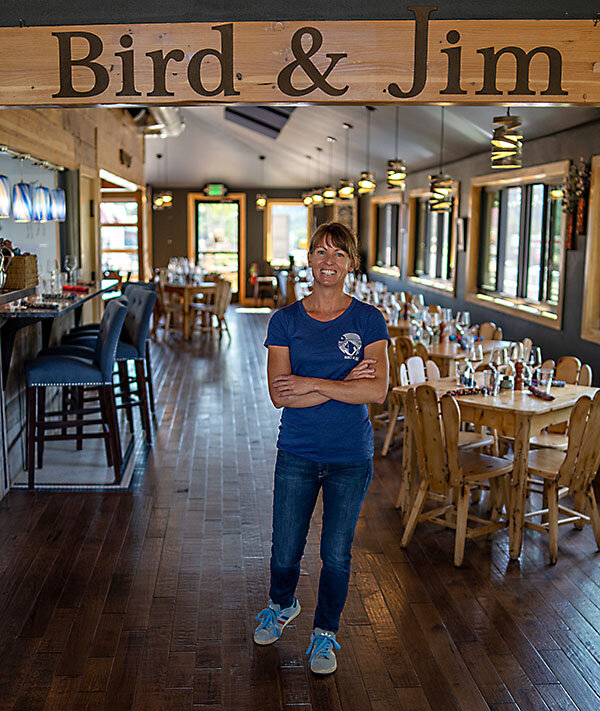Hiking boots welcome: Why gourmet eateries thrive near national parks
Loading...
| BAKER, NEV.
As the sagebrush-blanketed landscape of eastern Nevada gives way to pine-covered peaks, a tiny town pops up along State Route 487.
This is Baker, home to 30-some residents. Two of them trained at the now-closed California Culinary Academy.
Why We Wrote This
A story focused onForget bagged lunch and s’mores. The culinary scene outside national parks has evolved in recent years, delighting taste buds and giving visitors another reason to make the trek.
Twin sisters Cheri Phillips and Tabitha Degnan operate Sugar, Salt & Malt Restaurant. The unassuming eatery sits on the outskirts of Great Basin National Park, giving visitors and locals alike a gourmet experience in the middle of a literal food desert.
“You walk in the door, and you hear the nice music, and you sit down and get waited on, and you have good food,” Ms. Degnan says. “The dining experience from end to end is so much more than just handing someone a hamburger.”
As national park popularity grows, so do related businesses. That includes restaurants creating culinary scenes in hard-to-reach locales.
Melissa Strong owns two eateries in Estes Park, Colorado, outside the entrance to Rocky Mountain National Park. Ms. Strong says one of those, Bird & Jim, has seen sales double since the restaurant opened in 2017, a feat she attributes to offering the food and atmosphere visitors and locals are seeking.
“Come on in, in your hiking boots and your hiking clothes and dirty,” she says. “Celebrate what you just did.”
If you’re planning a trip to Great Basin National Park, pack some water and snacks for the road.
There isn’t a Starbucks, a McDonald’s, or even many gas stations along the miles and miles of two-lane roads cutting through the desert. But as the sagebrush-blanketed landscape gives way to pine-covered peaks, a tiny town pops up along State Route 487.
This is Baker, home to 30-some residents. Two of them trained at the now-closed California Culinary Academy.
Why We Wrote This
A story focused onForget bagged lunch and s’mores. The culinary scene outside national parks has evolved in recent years, delighting taste buds and giving visitors another reason to make the trek.
Twin sisters Cheri Phillips and Tabitha Degnan operate Sugar, Salt & Malt Restaurant. The unassuming eatery sits on the outskirts of the park, giving visitors and locals alike a gourmet experience in the middle of a literal food desert.
“You walk in the door, and you hear the nice music, and you sit down and get waited on, and you have good food,” Ms. Degnan says. “The dining experience from end to end is so much more than just handing someone a hamburger.”
It’s a far cry from a bagged lunch or s’mores around a campfire, but as national park popularity grows, so do related businesses. That includes restaurants creating culinary scenes in hard-to-reach locales. Ms. Degnan and Ms. Phillips saw an opportunity in 2020, when they purchased a restaurant building in Baker and rebranded it as their own. Today, it comes complete with cafe lights strung above an outdoor patio, a bar and dining area inside, and a coffee shop in an adjoining sunroom.
Great Basin National Park, known for its dark skies, ancient bristlecone pine trees, and limestone caves, has seen a visitation surge in recent years. A decade ago, about 92,000 people entered the park each year. Now, it welcomes north of 142,000 visitors annually.
They represent a small slice of the 312 million park visitors across the United States, who, in 2022, spent an estimated $23.9 billion in so-called gateway regions bordering the natural wonders. Nearly 20% of that spending went to restaurants, trailing only lodging, which accounted for about 38%.
Whether park visitors are clamoring for fine dining, adventurous eats, or comfort food is an open-ended question. But it’s likely that a meal out is on their itinerary. Cassidy Jones, senior visitation program manager for the National Parks Conservation Association, says more visitors want “structure and predictability” to their trip, meaning they’re supportive of efforts such as park entry reservations, which manage access and congestion.
A structured trip as opposed to a wandering visit may lend itself to a day packed full of activities in and around the park itself.
“I know that I’m getting in at this time, and then these are the other things that I have booked, and this is how my itinerary is going to go,” Ms. Jones says, referring to the thought process.
And for some, that to-do list may include a pre- or post-hike meal.
Melissa Strong owns two eateries in Estes Park, Colorado, outside the entrance to Rocky Mountain National Park. The Bird’s Nest, a grab-and-go cafe, offers “picnic backpacks” filled with vegetables, meats, cheese, and bread for parkgoers as they embark on their outdoor adventures. Bird & Jim, billed as “modern mountain dining,” sits across the street and serves menu items such as smoked pheasant chowder, lamb bolognese, and a “carnivore” entree featuring elk striploin, miso beef short ribs, and game sausage.
Ms. Strong says Bird & Jim’s sales have doubled since the restaurant opened in 2017, a feat she attributes to offering the food and atmosphere visitors and locals are seeking.
“Come on in, in your hiking boots and your hiking clothes and dirty,” she says. “Celebrate what you just did.”
As the demand grew, the logistics of operating a restaurant in the mountain town became easier, Ms. Strong says. Years ago, one or two food distributors would make a single trip up the hill each week, limiting what restaurateurs could offer customers. Now, multiple distributors journey to Estes Park, expanding menus as a result.
“We do have a seasonally changing menu,” she says. “You come visit us in January, you come visit us in July, and you’re going to have two different experiences.”
While Bird & Jim operates year-round, other restaurants outside parks follow seasonal schedules. Sugar, Salt & Malt, for instance, opens in early April and closes at the end of October.
The expanding culinary scenes outside national parks doesn’t mean that comfort food is obsolete. Brian Hays, one of the owners of Canyon Pizza Co. in Moab, Utah, says the group specifically chose to open a pizzeria because pizza is a popular food that generally falls at an affordable price point.
Mr. Hays, who also works as a ranger within a national park, says he has friends drawn to Moab in part for its burgeoning food options. But pizza is a staple that people tend to crave after a day exploring the nearby Canyonlands National Park.
“If you ride bikes all day, go climbing all day, go trail running all day, it’s just the kind of food that works well in a town like this,” he says.
Back in Baker, Cindy and Greg Dewey decided to forgo their picnic lunch after a hike in Great Basin National Park. Instead, they ate sandwiches at Sugar, Salt & Malt.
The couple regularly visit national parks and have made it a point to try neighboring restaurants. The Deweys say they have been pleasantly surprised to find gourmet-style food in many of the small towns bordering parks.
“It has gotten very ‘bougie,’” Ms. Dewey says, referring to the food scene outside Zion National Park in Springdale, Utah.
After working in high-end restaurants in places such as the Florida Keys and Vail, Colorado, Ms. Phillips and Ms. Degnan of Sugar, Salt & Malt decided to move closer to where they grew up in Utah. They started a catering and coffee-cart business, which later morphed into the restaurant in Baker. During the first season their restaurant was open, they changed the menu almost weekly, gaining a sense of customers’ preferences.
“They wanted steak. They wanted fish. They wanted nicer items,” Ms. Degnan says. “They didn’t want just cheap food.”
Nowadays the menu consists of items such as braised lamb ribs, smoked tri-tip, and lasagna. But they leave room to innovate for special occasions, such as the recent solar eclipse, which drew spectators to the region’s dark skies.
Ms. Degnan described it as a day to “pull out the tablecloths and polish the silverware.”
On the eve of the eclipse, 60 people packed the remote restaurant for a four-course meal featuring corn chowder, butternut squash ravioli, New York strip steak with gorgonzola gnocchi, and crème brûlée, Ms. Phillips says.
Consider it dinner and a show.











